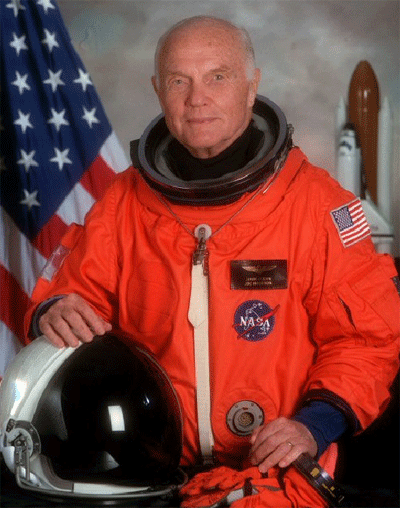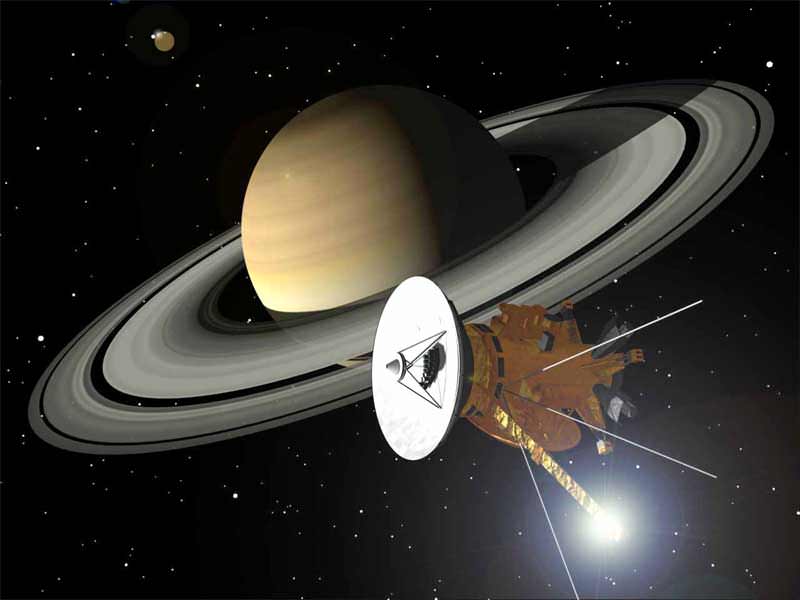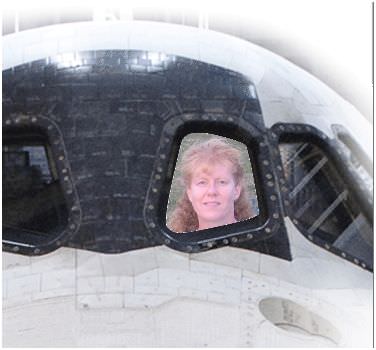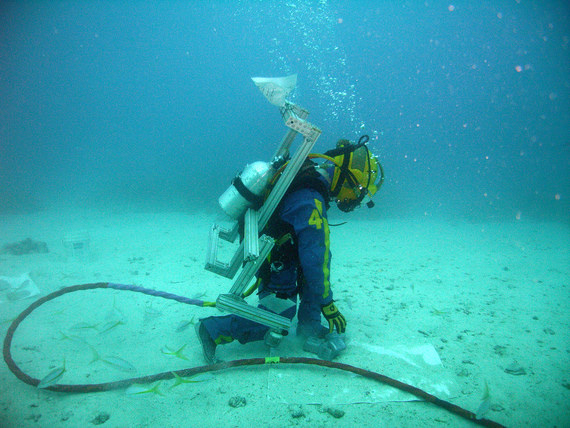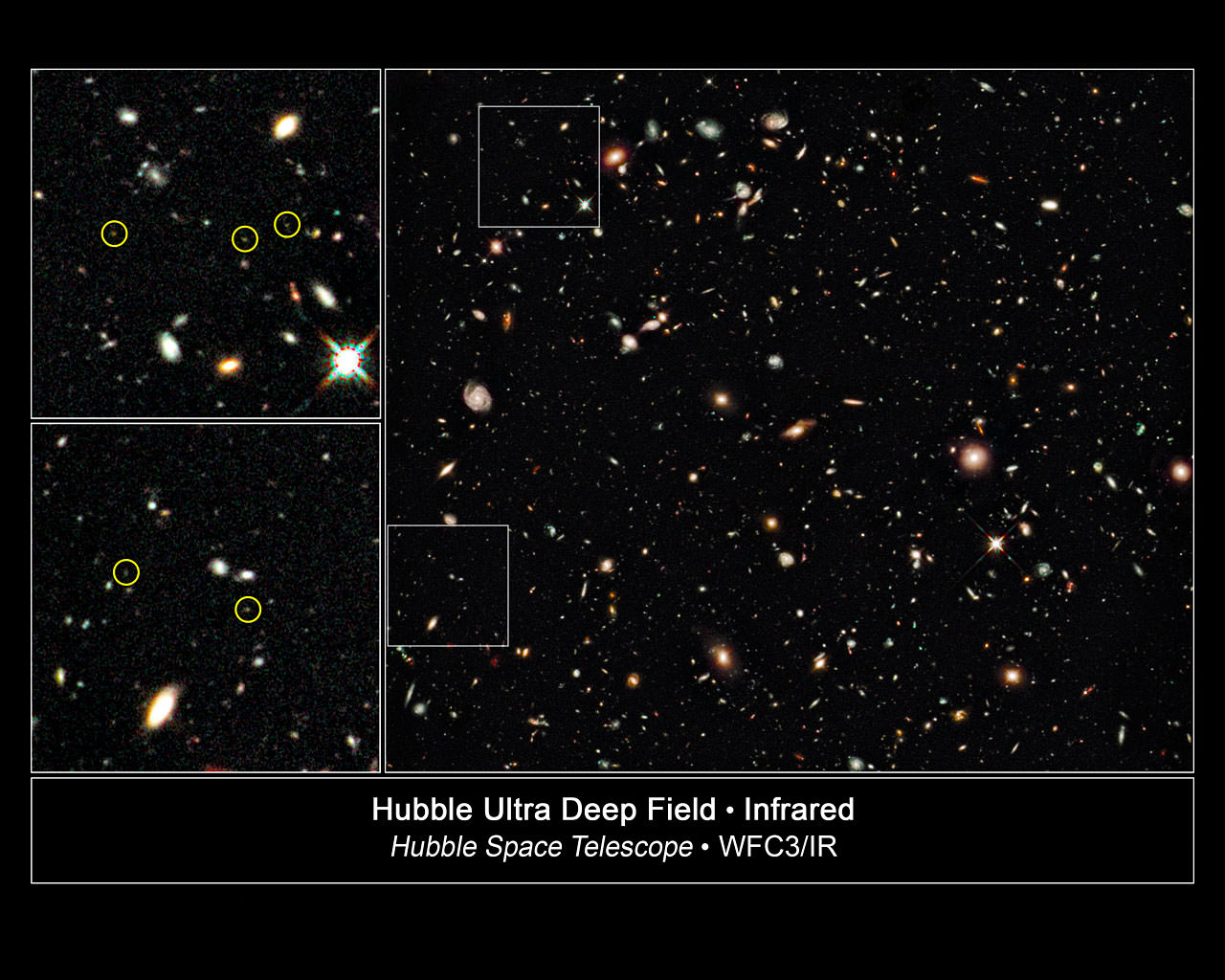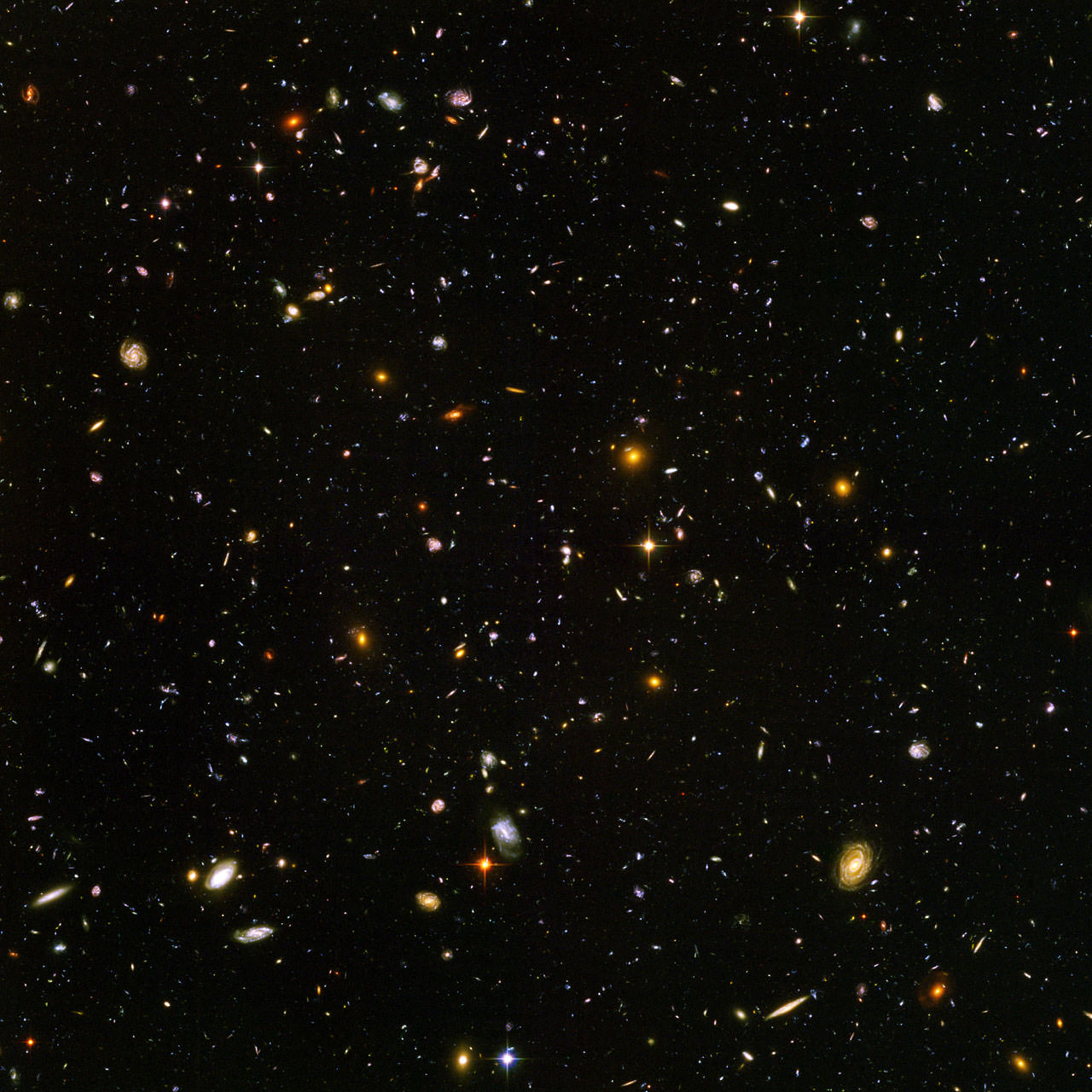Since I can’t even master Mario Kart, I’ll probably stay clear of NASA’s new online game, Moonbase Alpha, out of fear of crashing the Moon rovers and destroying the lunar colony. But for those of your that enjoy video games, NASA has teamed up with Virtual Heroes to create this new game. Here’s the blurb:
Continue reading “For the Gamers Out There: Moonbase Alpha”
John Glenn: Keep the Space Shuttles Flying
[/caption]
US spaceflight legend John Glenn has weighed in on the current human spaceflight debate, releasing an 8-page paper outlining his feelings and a potential plan to allow US astronauts to keep launching on US vehicles. While Glenn supports President Barack Obama’s plan to extend operations of the International Space Station and to forego returning to the Moon for the time being, he thinks retiring the space shuttles at this point is a mistake.
“The world’s only heavy lift spacecraft and the U.S.’s only access to space should stay in operation until suitably replaced by a new and well tested heavy lift vehicle,” Glenn wrote. “The Shuttle system is working extremely well, has had systems upgrades through the years, and has had “the bugs” worked out of it through many years of use. The Shuttle is probably the most complex vehicle ever assembled and flies in the harshest of environments. Why terminate a perfectly good system that has been made more safe and reliable through many years of development?”
But Glenn said the US also needs to develop heavy lift capability, and do it sooner rather than later. And while he supports the plan for NASA to contract with commercial companies to ferry astronauts and some cargo to and from the ISS, he also said NASA can’t rely solely on commercial space vehicles, which at present are unproven in their reliability.
Keeping the space shuttle program going would cost about $1 Billion a year. “That is a very small price to pay for maximizing the benefits from a $100 Billion national investment, and may even be cheaper than the final bill from the Russians,” Glenn said.
He blames NASA’s current predicament on Congress for not adequately funding the Constellation program.
He erred, however, in his statement that the “U.S. for the first time since the beginning of the Space Age will have no way to launch anyone into space – starting next January.” NASA did not launch humans into space from July 1975 to April 1981 – the end of Apollo and Skylab until the beginning of the shuttle era, as well as when spacecraft were grounded following the Apollo 1 fire in 1967, the Challenger accident in 1986 and the Columbia accident in 2003.
Glenn is the latest former astronaut to join the debate on NASA’s future and while some ex-astronauts are staunchly against cutting the Constellation program to return to the Moon, and others wholly endorse the plan, Glenn seemingly takes a middle ground.
Here are his suggested objectives:
Short Term
Extend the Shuttle. It is key to ISS ready access. Phase-in new space access providers only as they become experienced and have proven reliability.Maximize research on the ISS – plan with the science community.
Use the ISS for long term Mars mission training.
Develop a fully tested replacement heavy-lift capability.
Long Term
Robotic exploration of Mars and other destinations such as asteroids.
Continue ISS research as long as it is making substantial contributions.
Increase preparation and planning for a Mars mission.
Determine – earth-to-Mars, or assembled-in-earth-orbit – to Mars.
Set a firm schedule –Go for Mars.
You can read Glenn’s full statement here.
This is not the first time Glenn has proposed to keep the shuttles flying. In 2008, he said “The shuttles may be old, but they’re still the most complex vehicles ever put together by people, and they’re still working very well,” he said after a Capitol Hill ceremony marking NASA’s 50th anniversary.
Needed: Plutonium-238
[/caption]
Sometimes people ask what they, as a regular citizen can do to help NASA. Emily Lakdawalla at the Planetary Society Blog posted this today, and this is definitely something to write to members of Congress about. NASA is running out of plutonium-238, which is used to power deep space probes, but it’s unclear whether Congress will provide the $30 million that has been requested for the Department of Energy to start new production.
Plutonium-238 has powered dozens of spacecraft, including the Voyager probes, the Galileo mission to Jupiter, and the Cassini spacecraft that is currently sending back such amazing images of Saturn’s rings and moons. Because of spacecraft powered by plutonium-238, we now know — among other things — that there are volcanoes on Jupiter’s moon Io and geysers on Saturn’s moon Enceladus.
Plutonium-238 was a by-product of Cold War activities, and the U.S. has not made any new supplies since the 1980s. Since 1993, all of the plutonium-238 the US has used in space probes has been purchased from Russia. It’s not the same as plutonium-239, which is used in nuclear weapons; a small marshmallow-sized pellet of plutonium-238 gives off heat, which is used to power spacecraft that can’t rely solely on energy from solar panels. Without this energy source, future missions could be canceled.
Emily posted this letter from the chair of the Division of Planetary Sciences of the American Astronomical Society Candy Hansen:
Members of the DPS Federal Relations Subcommittee and the DPS committee carried out our annual “Hill” visits May 13 to key members of Congress. We had two messages – restart domestic production of plutonium-238, and our concerns about R&A carry-over language. With regards to the production of plutonium-238, we are not out of the woods. We still need to convince the members of the Appropriations Subcommittee on Energy and Water that this is a critical need right now – that NASA is already curtailing missions to the outer solar system, and anywhere else plutonium-238 is required (the New Frontiers 3 Announcement of Opportunity ruled out missions which require plutonium-238).
In particular we need constituents of the following states to write letters:
Senate Appropriations Committee Subcommittee on Energy and Water Development:
Dorgan (ND)
Byrd (WV)
Feinstein (CA)
Bennett (UT)
Hutchison (TX)
Murray (WA)
Bond (MO)
Alexander (TN)
Shelby (AL)Also, Johnson (SD), Cochran (MS), Harkin (IA), Landrieu (LA), Lautenberg (NJ), McConnell (KY), Reed (RI), Tester (MT), Voinovich (OH).
If these are your representatives we need you to write:
House Appropriations Subcommittee on Energy and Water Development:
Visclosky (IN)
Frelinghuysen (NJ)
Edwards (MD)
Pastor (AZ)
Davis (TN)Or you live in these districts: IN-01, TX-17, AR-01, PA-02, NY-02, OH-17, MA-01, TN-04, CO-03, NJ-11, TN-03, ID-02, MT, CA-44 and LA-05.
We have a handout that you may wish to send with your letter.
For more background and a letter template, see this page.
Thanks for your efforts!
Candy Hansen
Send Your Face to Space On Final Two Shuttle Missions
[/caption]
If NASA offered you a ride on one of the final two scheduled space shuttle missions, you’d go, right? I know I would, so that’s why I immediately signed up for NASA’s newest public participation campaign, “Send Your Face to Space.” If I can’t go, at least my face is heading up to LEO.
Here’s how to participate and become part of history:
Head to the “Send Your Face to Space” website.
Hit the “Participate” button and upload your image, which will be flown aboard the space shuttle. Don’t have a picture to upload? No problem, just skip the image upload and NASA will fly your name only on your selected mission.
Next… Print and save the confirmation with your flight information.
Later… Return to the site after the landing to print your Flight Certificate – a commemorative certificate signed by the Mission Commander.
The website also provides a participation map showing where participants are from and, relative to each other, how many are taking part from each country.
The Last Train to KSC: Final Set of Solid Rocket Boosters Arrive
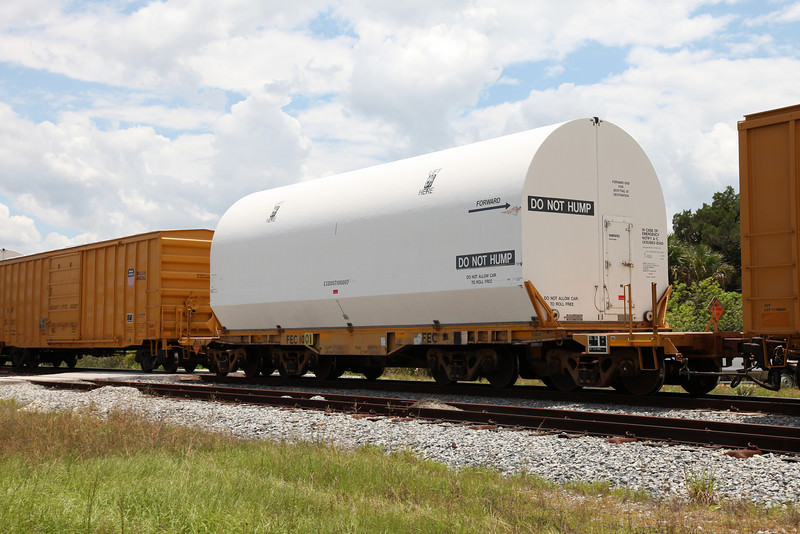
[/caption]
Another end-of-an-era event heralding the conclusion of the space shuttle program: the final set of space shuttle solid rocket booster segments arrived at the Kennedy Space Center on Thursday, May 27, 2010. The segments were carried on railway cars from the ATK factory in Utah where the boosters are built. The last part of the trip from Jacksonville, Florida included passenger cars carrying NASA personnel and ATK officials, including astronaut Mike Massimino, shuttle launch director Mike Leinbach, and the “voice” of NASA TV, George Diller. The train stopped across the Indian River from KSC where the tracks lead to the Vehicle Assembly Building.
The boosters will be stacked in the VAB for a possible rescue mission, or perhaps, even one last add-on flight for space shuttle Atlantis.
The SRB segments are designated for STS-335, the Launch-On-Need mission that would be flown if the last scheduled shuttle flight — STS-134, now scheduled for launch in late November — would encounter a problem. Or, if Congress allows, another shuttle mission using the ready-to-go shuttle could be added. U.S. Sen. Bill Nelson told President Obama in a letter this week that he intended to request funding for the extra mission. NASA hopes to get a go-ahead for the flight, which would become the STS-135 mission, by late June. If approved, the likely launch date would be sometime in the summer of 2011.
NASA’s Associate Administrator for Space Operations Bill Gerstenmaier said at a news conference this week that if the additional flight were approved, a Soyuz would be readied as a rescue vehicle, and the shuttle crew would be smaller, probably 4 crew members. The crew could take safe harbor at the International Space Station, if needed, until the rescue Soyuz arrived. The shuttle could bring extra supplies and hardware to the ISS.
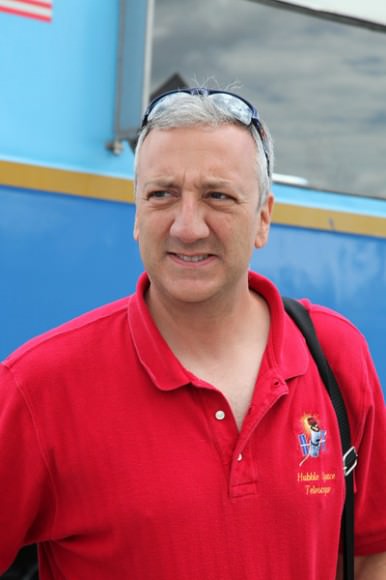
Veteran astronaut Mike Massimino told a Florida television station crew that he hopes for an additional shuttle mission. “I think we have to be optimistic,” Massimino said. “There are just too many people around the country and the world who are so supportive of our program.”
ATK laid off 1,300 of their 5,000 person workforce because of shutting down production of the boosters, but the company is hoping to be part of NASA’s future spaceflight plans.
“There’s quite a bit of uncertainty,” said ATK KSC Deputy Director Ted Shaffner. “The direction is very cloudy from our politicians and NASA is struggling with what direction we do take.”
More images from the event:
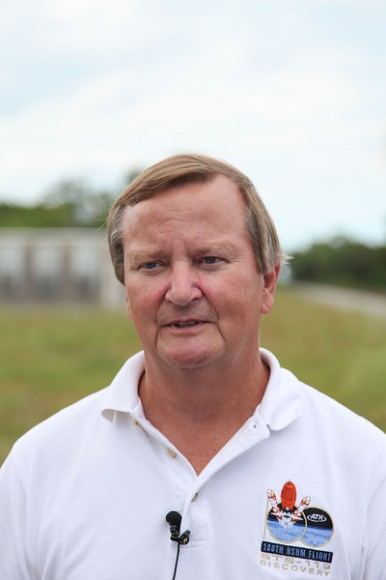
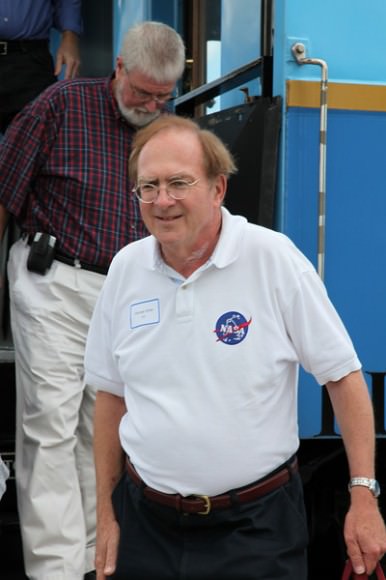
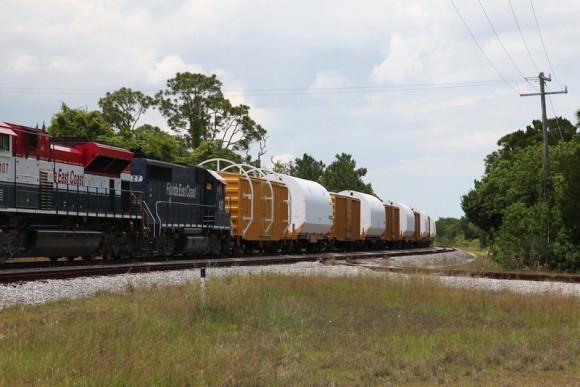
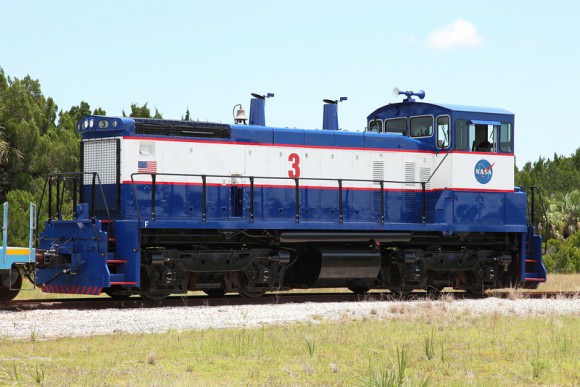
And I know someone is going to comment on the “Do Not Hump” sign on the railcar. What it means is that the contents of the railcar are delicate enough that the car should not be ‘humped,’ which is a method to sort freight cars by rolling them down a hill instead of using a locomotive engine to move the cars. Obviously, NASA and ATK don’t want the SRB segments to go rolling down a hill. Find out more about humping here.
Sources: Florida Today, CFNews 13
First Orion Capsule forming rapidly
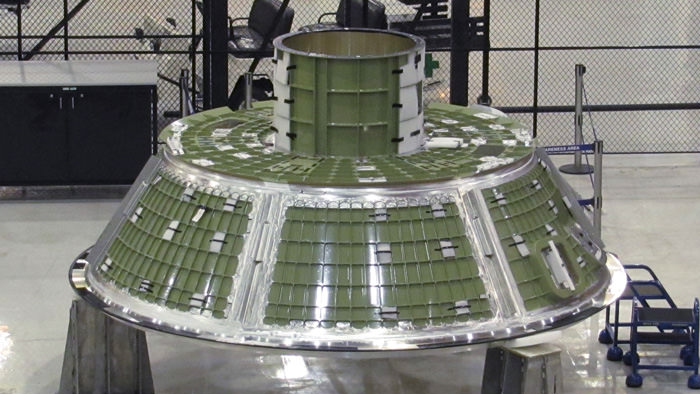
[/caption]
The first Orion crew capsule is rapidly taking shape as assembly work to construct the skeletal framework of the first pathfinder Orion capsule – the Ground Test Article – or GTA, is nearing completion.
The Lockheed Martin team building Orion is just one weld away from completing the framework of an Orion cabin at NASA’s Michoud Assembly Facility in New Orleans. Precision welding to join together the final large skeletal segments (see my earlier report) has proceeded well according to Lockheed managers I spoke with.
“The Orion capsule is the Congressionally approved program of record and we are moving forward with it”, says Larry Price, Lockheed’s Orion Deputy Program Manager in an interview with me. “Our work is continuing with the funding which is still approved until September 2010. Orion is a very functional vehicle. All subsystems will be state of the art.
“Orion is not Apollo on Steroids”, Price emphasized.
“We are building on what is known and it’s a very contemporary approach. The flight avionics are very similar to commercial airliners. We can take advantage of the latest advances in avionics and computing. Orion has been designed for long duration interplanetary functionality to operate beyond Low Earth Orbit (LEO) for 6 months or more to visit the Moon, Asteroids, Lagrange points and other targets of interest for scientific investigation”, Price explained.
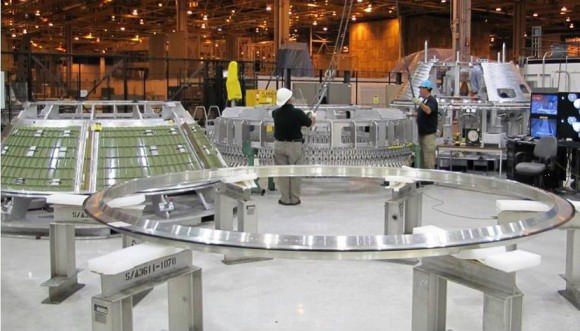
“The Orion project status is we have just one more weld remaining on the crew cabin”, says Tim Knowles. He is the Orion GTA Vehicle manager for Lockheed Martin and discussed Orion development in an interview with me. “When all follow on work to prepare the GTA is done, the final Orion GTA crew cabin will look very much like a real Orion capsule,” Knowles said.
“The final close out weld will join the Forward Cone Assembly and Crew Tunnel to the barrel shaped Aft Assembly. This combined piece then comprises the habitable volume and forms the first structural framework for the first Orion Crew Cabin”.
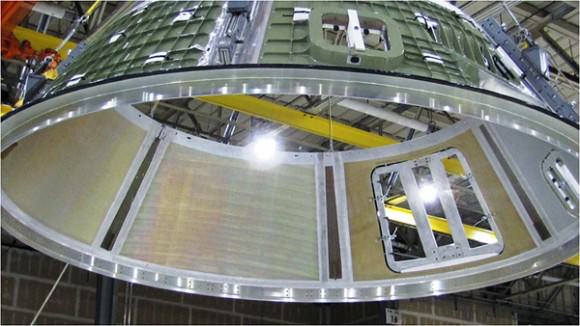
“The welding process uses a technique called Friction Stir Welding (FSW)”, Knowles said. “It has produced acceptable results so far. It’s a learning process and not flawless, and improves each time we do it” added Knowles.
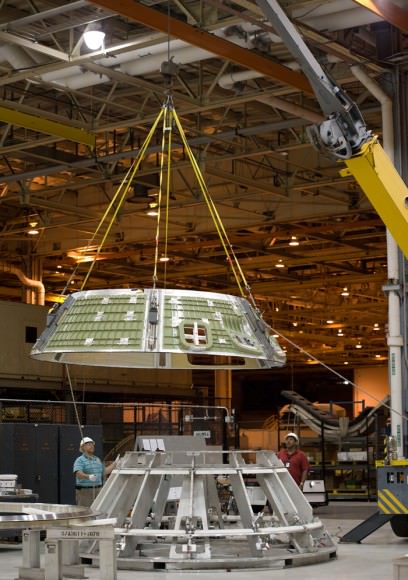
“We use sound to evaluate the work and detect any flaws”, explained Knowles. “The testing method is called Phased Array Ultrasonic Testing (PAUT). It’s a Non-Destruction Evaluation (NDE) technique. Remember, the GTA is intended as a manufacturing pathfinder as well as a structural test article”.
“The actual welding times to combine the individual segments requires only about 45 minutes to an hour. Of course the real trick to getting a good weld is that it takes many many days of preparation work to get the parts and equipment and everything else set up properly,” explained Knowles.
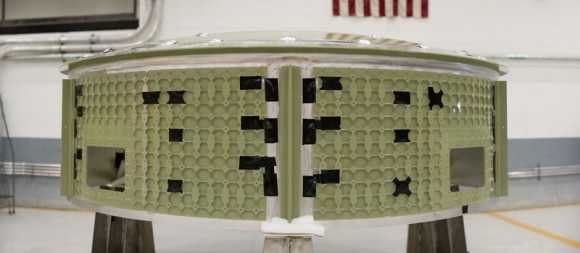
“Most of the work on the parts needed to complete the GTA after completion of the welding is well along. They will be installed inside following a pressure test of the crew cabin that is scheduled for June. These include mass and volume simulators for items like the crew seats and consoles, lockers, waste management etc. On the outside we’ll add simulators for the parachutes, compressed gases, propellants and thrusters all around the shell we welded together”.
“Then we’ll add the simulated [cone shaped] thermal protection system (TPS) aeroshell around that, including a few real TPS tiles. We will also add a heat shield.”
“When we are done adding everything, the final Orion GTA will look very much like a real flight article of the Orion capsule”.
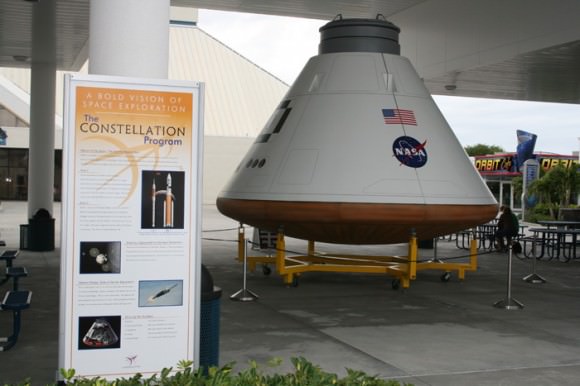
“The GTA will then be placed in a chamber and bombarded with acoustic energy for environmental correlation tests. These tests simulate the flight environment to collect data for the purpose of comparing the results to our predictive models, updating the models, and then refining the design of the crew cabin”.
“We are planning to ship the GTA to our Lockheed facility in Denver around the end of October. It will be integrated with a simulated Launch Abort System to form a launch abort vehicle (LAV) that will subjected to further vibro-acoustic tests next spring. Then the GTA crew module will be shipped to NASA Langley for water drop landing testing to simulate the impact. Those tests will run into 2012”.
“About 86 people are currently working on various aspects of the Orion GTA project at Michoud”, according to Lockheed spokesman Kevin Barre.
The GTA is a key pathfinder vehicle and the first full-sized, flight-like test article for Orion. It will be subjected to numerous stringent tests which are crucial learning exercises that will help validate the cabin design and will be used to incorporate changes to the tools and manufacturing processes that will eventually lead to a human rated production vehicle.
This Orion GTA capsule is an indispensible forerunner to the next generation Orion vehicle which NASA had planned for human flights to shot to the Moon and the International Space Station (ISS). It is not an unmanned “rescue capsule”, or lifeboat, as recently proposed by President Obama at his April 15 space policy speech at the Kennedy Space Center (KSC).
President Obama’s new announcement to resuscitate Orion as a “rescue capsule” was a significant refinement to his original plan of February 2010 to wholly terminate Orion and Project Constellation as part of his initial 2011 NASA Budget proposal which would radically alter the future path of NASA.
Related stories by Ken Kremer
Finding NEEMO Helps NASA Prepare for the Future
[/caption]
Talking with the astronauts living in the NEEMO habitat – NASA’s Extreme Environment Mission Operations – is a bit like talking with Darth Vader; there’s a regular hiss of air intake and outflow in the background. But the ever-present pastel blue hue in the webcam feed lets you know these astronauts aren’t in space. They are living and working in an underwater habitat, 20 meters (70 feet) under the ocean, just off the coast of Key Largo, Florida. What are NASA astronauts doing under the sea?
“This is the closest thing to spaceflight I’ve ever had in all my NASA training,” astronaut Tom Marshburn told Universe Today in the midst of his 14-day stay in NEEMO. “It is very real. Our lives are completely dependent on our habitat, we have to follow checklists and procedures to be safe, we have to watch out for each other, we’re in a tight confined space and doing real work that will help future space missions. So, in all ways it is much like spaceflight, including having a great view out the window.”
Except in space, there wouldn’t be a giant grouper peering through the portal.
The habitat, called Aquarius, is the world’s only undersea laboratory. Mainly it is used for marine research but NASA has found it has great utility for training crews to live in space. “It’s the closest thing to spaceflight without going to space,” Marshburn said. “We’re able to do operational research, work that is applicable to what we need to know about flying in space. We also do life sciences research and some marine research.”
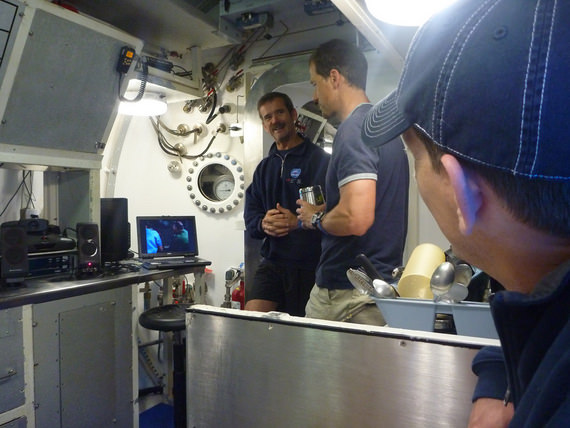
Joining Marshburn is Canadian astronaut Chris Hadfield, who is the commander for this undersea mission, as well as the Lunar Electric Rover Deputy Project Manager Andrew Abercromby and Steve Chappell, a research scientist, along with two technicians.
Aquarius itself is a long cylinder, “like a couple of Winnebagos set end to end,” Marshburn said, with a box-like entry at one end called the Wet Porch.
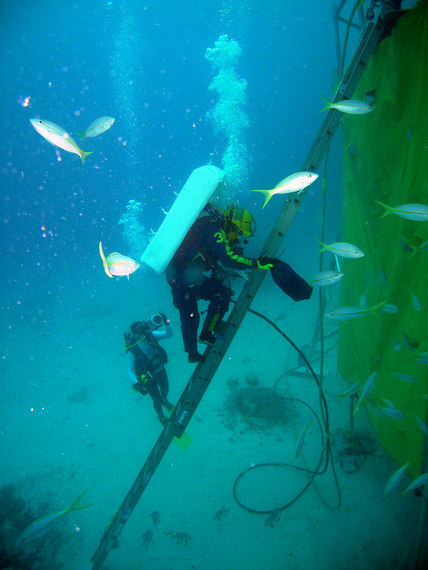
“When we dive into the Wet Porch, there is no hatch. The air pressure keeps the water out. There is cool pneumatic sliding door like something out of Star Trek, and you just walk on in. There’s a galley where we eat backpacking type food, we sleep in a bunk room. There’s six of us in a room about the size of a closet. You get to know your crewmates really well.”
The main working area of Aquarius is filled with valves, dials and lit panels. “It’s a lot like a spaceship,” Marshburn said.
Marshburn and Hadfield are members of the 14th NEEMO crew. The tasks and objectives for their mission, besides giving them training for a long-duration space mission is to do operational research on spacesuits for different gravity and environment requirements (on an asteroid, Mars or on the Moon).
“As you may know, astronauts train underwater in spacesuits, so this is a great place to work on spacesuit design,” said Marshburn, “specifically finding where the center of gravity is and what mobility issues there might be. Instead of just diving in the pool, it turns out we can get a lot more done by being down here and going out with the equipment on the sea floor, and be able to spend hours working on spacesuit design.”
The NEEMO 14 crew is doing intense research on the center of gravity and how that affects the ability to perform standard tasks, and helping spacesuit designers increase range of motion and maintain the comfort level for the astronauts on different planetary surfaces.
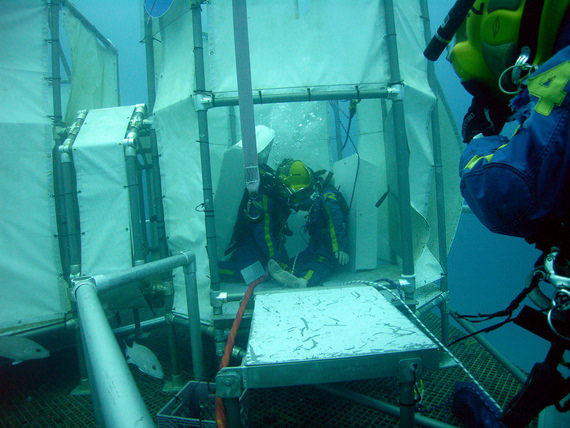
“If we want to explore an asteroid, how do you move around without handholds or something to grab on to?” said Hadfield in a press conference from Aquarius. “Where should the center of mass be for mundane tasks like picking things up or shoveling, or for complex tasks like rescuing a injured crew member? We’re finding that sometimes the center of gravity that is completely wrong on Earth — that would give you a backache in a matter of minutes — works better in a different gravity environment. And that’s what we are trying to figure out. If what we’re finding out is a surprise, that means our simulation is really doing its job.”
The suits can be weighted out to simulate different gravity. The crews do “EVAs” — like spacewalks, going outside every morning and afternoon.
On the ocean floor are also mockups of a lunar rover and lander. Tests for these include hatch design, and ingress and egress simulations. The crew is also doing life sciences experiments, themselves being the subjects. “We’re in a hyper-oxygen environment,” said Marshburn, “that plus living in a confined environment is a lot like living in space and it puts our bodies under stress, so that is being studied, as well as psychological studies. We’re trying to maximize our time down here, so we’re also doing marine geology research.” They also do regular maintenance of the exterior of the habitat.
Marshburn said future designs for spacesuits, rovers, and landers will be based, in part, on what is learned from the NEEMO missions.
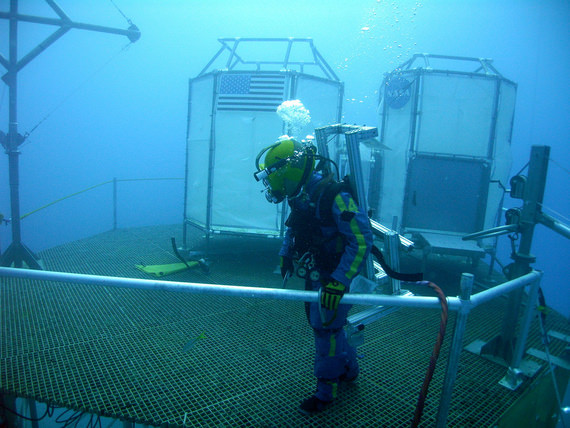
This past week the crew has been in a Mars communication simulation, where there is a 20 minute delay each way for messages – both written and spoken — back and forth from “ground control” on the Earth’s surface. “That has really changed things,” Hadfield said, “it increases our level of isolation. It’s just the six of us with each other with only peripheral help. It forces us to make our own decisions.”
However, the crew has been Twittering during the mission is real-time, an activity Hadfield said he was initially suspicious of. “Twittering was foreign to me, and I only knew it would increase the crew’s work load.”
But what does he think about it now?
“I am delighted with what it has done,” Hadfield said, “not only with our ability to interact with the world, but it forces us to express what we are thinking about. This experience, and the experience of spaceflight is so remarkable that you really shouldn’t horde something that is important to you, or something remarkable that happens. So thousands of people now are following what we are doing down here. This new technology to spread the human experience has allowed us to better articulate to each other, too.”
Hadfield said he is a big proponent of Twitter now, as schools and other organizations have been able to be part of the NEEMO 14 mission.
The mission started on May 10, and the crew will “depressurize” over the weekend to prepare for returning to the surface early next week. It takes at least 16 hours to get the excess oxygen out of their blood. If there would be an emergency, there are backup plans for getting the crew out and keeping them underwater and depressurizing.
Hadfield will be taking a turn on a future long duration space station mission and Marshburn said he is in line for tour of duty on the ISS as well.
“This is best spaceflight simulation I’ve ever had,” he said. “NASA likes to keep their astronauts trained, and believe me, this is worth it. It is very cool.”
Webcams from Aquarius.
Follow NASA_NEEMO on Twitter
See more images from NEEMO 14 on NASA’s Flickr page.
Hubble, Renewed, Reinvigorated, Raring to Go
Note: To celebrate the 20th anniversary of the Hubble Space Telescope, for ten days, Universe Today has featured highlights from two year slices of the life of the Hubble, focusing on its achievements as an astronomical observatory. Today’s article looks at the last two years, to April 2010.
The stakes for the fifth, and final, Hubble servicing mission couldn’t have been higher; not only were two new instruments to be installed (a relatively straight-forward task), not only was much of key infrastructure to be replaced (batteries, fine-guidance sensors, thermal blankets), but intricate repairs had to be performed on the two most complicated instruments (ACS and STIS), something not in the design, something difficult enough in a well-appointed lab on Earth much less done by astronauts in bulky space suits. The servicing mission was postponed, as it became clear that the work to be done was more extensive; but in May 2009 STS-125, involving five full days of space walks and 11 days in space, met all the objectives.
And a little under four months later, after extensive testing and calibration, the Hubble was back in the astronomy business.
This image is the Hubble Ultra-Deep Field (HUDF), as seen by WFC3 in the infrared (now that Hubble Zoo is live, you will have a chance to analyze fields like this yourself!)
[/caption]
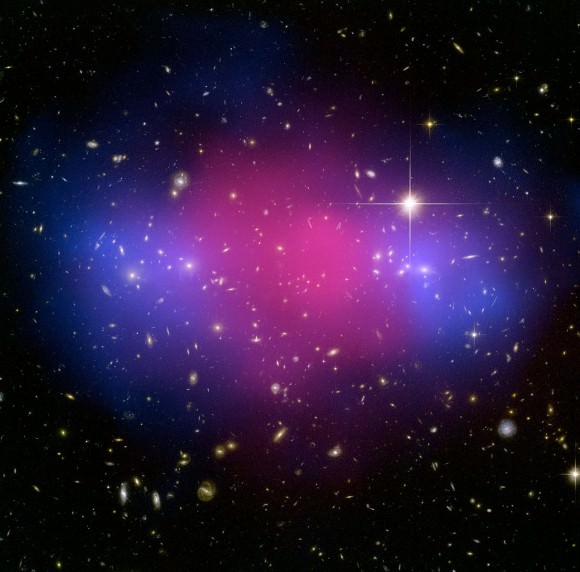
MACS J0025.4-1222 is not as well known as the Bullet Cluster, but perhaps it should be. One of the really big, open questions in astronomy today is the nature of dark matter; observations of the Bullet Cluster point to dark matter being a form of matter that does not interact with normal (baryonic) matter, except gravitationally. But perhaps the Bullet Cluster is just an anomaly, or perhaps we don’t really understand what’s going on? In astronomy, as in all science, independent verification is key, and what better way to provide that, for dark matter, than to observe another interacting cluster? “Revealing the Properties of Dark Matter in the Merging Cluster MACS J0025.4-1222” is the paper to read, and Hubble’s ACS provided many of the key observations.
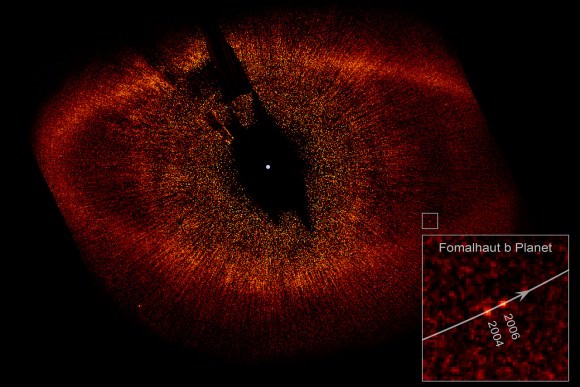
A direct image of an exoplanet, and an estimate of its orbit; the coronagraph on ACS blocked out most of the light of Fomalhaut so its planet – Fomalhaut b – could be seen.
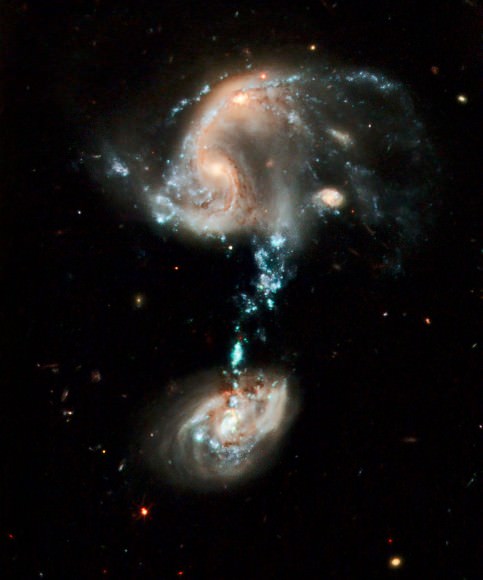
WFPC2 was removed during SM4 (and replaced by WFC3); this was Hubble’s workhorse camera for some 16 years, the camera which just kept on working. It is fitting then that one of its last images is of Arp 194, dubbed ‘the fountain of youth’.
Previous articles:
Hubble’s Late Teen Years: It Was the Best of Times, It Was the Worst of Times
Hubble Turns Sixteen, and Just Keeps on Working
Hubble Enters its Teen Years, More Powerful, More Ambitious
Hubble’s 20th: At Least as Good as Any Human Photographer
Hubble’s 10th Birthday Gift: Measurement of the Hubble Constant
Hubble at 8: So Many Discoveries, So Quickly
Hubble’s 20 Years: Now We Are Six
Hubble’s 20 Years: Time for 20/20 Vision
Hubble: It Was Twenty Years Ago Today
Sources: HubbleSite, European Homepage for the NASA/ESA Hubble Space Telescope, The SAO/NASA Astrophysics Data System
Hubble’s Late Teen Years: It Was the Best of Times, It Was the Worst of Times
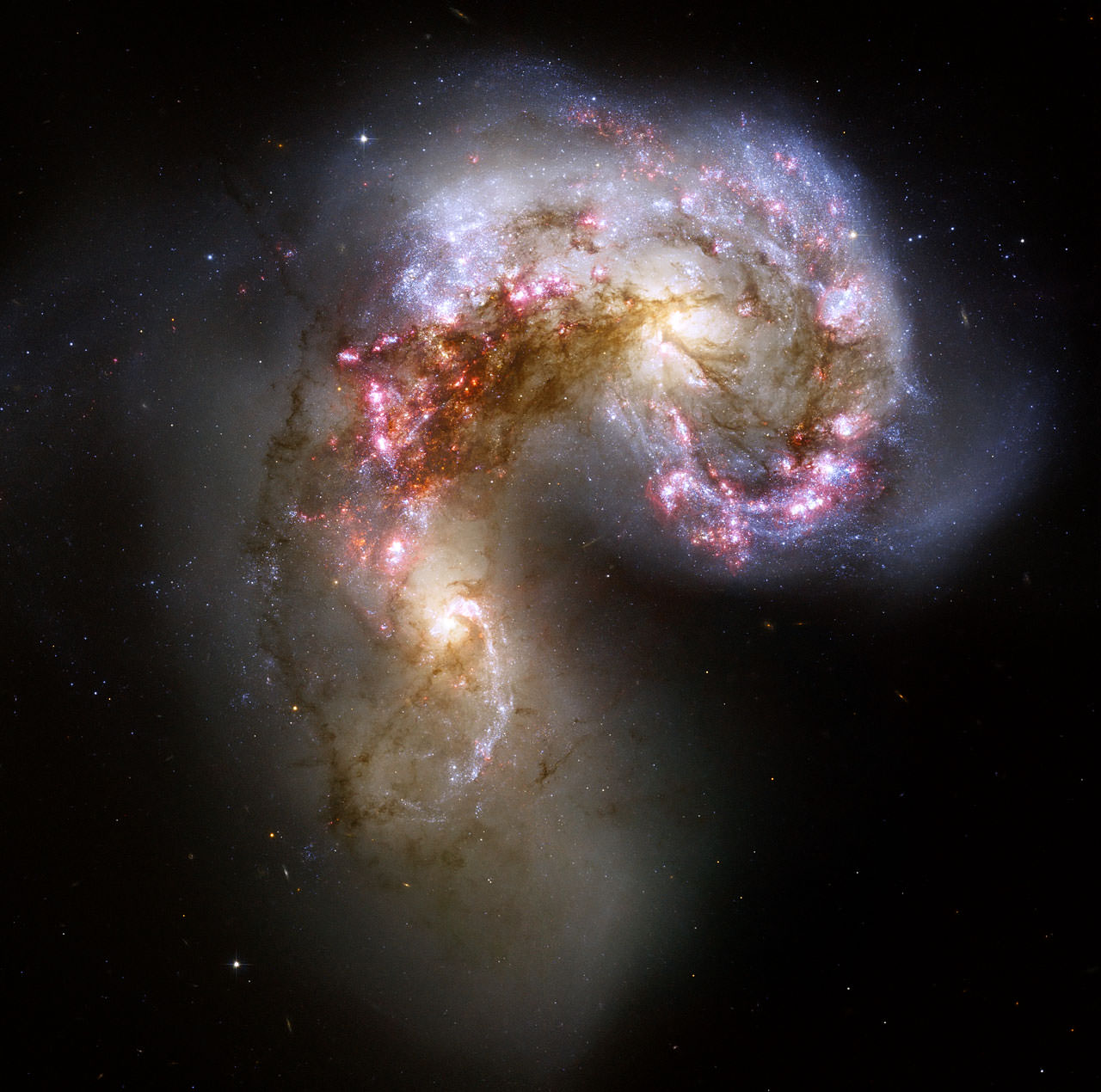
[/caption]
Note: To celebrate the 20th anniversary of the Hubble Space Telescope, for ten days, Universe Today will feature highlights from two year slices of the life of the Hubble, focusing on its achievements as an astronomical observatory. Today’s article looks at the period April 2006 to April 2008.
The image of the Antennae galaxies, above, released on October, 17 2006, is bitter-sweet. On the one hand it’s a stunning image, even more spectacular than the one taken nine years earlier with WFPC2; on the other the star instrument which took it, Advanced Camera for Surveys (ACS), failed first in July 2006, and again in January 2007. On top of that, one by one the Hubble’s gyroscopes started to fail, and its batteries too. In October 2006 the new NASA Administrator, Mike Griffin, had given the go-ahead for one last Space Shuttle mission to the Hubble, for a final servicing. With failure following failure, the servicing mission become more and more complex, and it was hard to maintain optimism in the future of Hubble.
The ACS’ failure came after it had completed its part of the Cosmic Evolution Survey (COSMOS), which was a coordinated project involving many of the world’s leading observatories, both on the ground and in space (a bit like GOODS, which I covered in yesterday’s article). Among the successes of COSMOS was this 3D map of the distribution of dark matter.
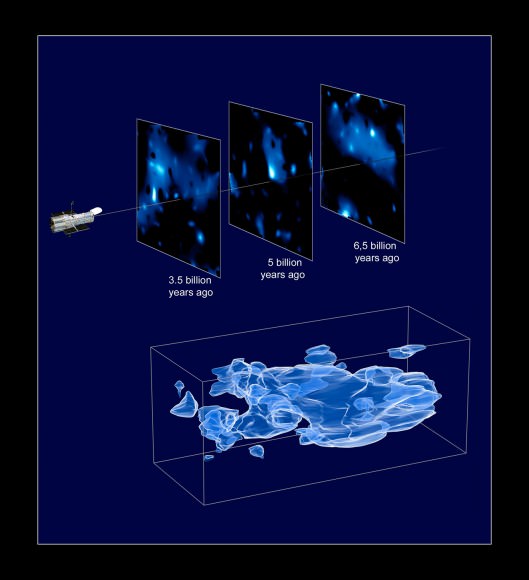
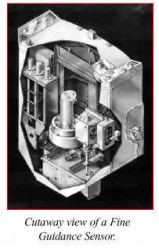
The way the Hubble keeps its gaze steady, during the sometimes quite long exposures of some of its instruments, is a marvel of modern engineering. Central to this intricate system is a set of sensors, called the Fine Guidance Sensors (FGS), which were designed to do science too, specifically astrometry.
The sensors aim the telescope by locking onto guide stars and measure the position of the telescope relative to the object being viewed. Adjustments based on these constant, minute measurements keep Hubble pointed precisely in the right direction.
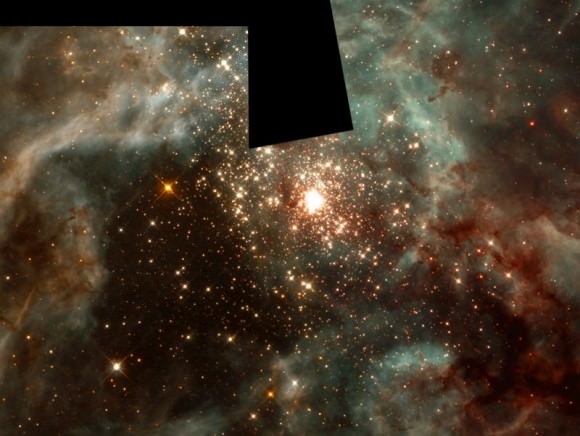
One of most interesting results from the FGS is the finding that the main star in the R136 cluster in the 30 Doradus nebula (better known as the Tarantula Nebula in the Large Magellanic Cloud) – R136a – is actually a triple (“Hubble Space Telescope Fine Guidance Sensor interferometric observations of the core of 30 Doradus“). Once upon a time the entire cluster was thought to be a single star, the most massive one ever seen; today R136a1 weighs in at ‘merely’ some 30 to 80 sols.
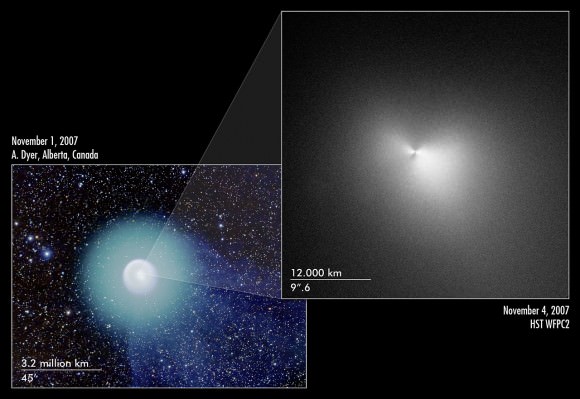
Comet Holmes is certainly one of the most memorable comets of recent times, not so much for its spectacular tail, but for its odd behavior; Hubble observed it several times Finally, Hubble’s View of Comet Holmes is the Universe Today story on this.
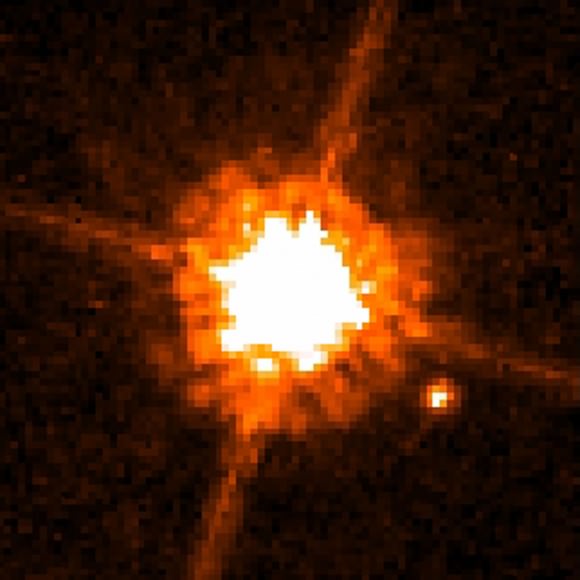
One of the most difficult challenges astronomers face, in doing science, is understanding and accounting for biases. For example, how could you tell, just by examining the approximately 6,000 stars you can see with your unaided vision, that none of them are examples of the most common kind of star! The nearest, brightest red dwarfs are far too faint to see without a telescope (do you know what their names are?), and it’s no easy matter to even find these stars. And what about stars that are fainter still, stars that aren’t quite stars, brown dwarfs? The first, certain, brown dwarf was not discovered until 1995, but since then our understanding of them has improved dramatically, and Hubble’s ACS has helped greatly in that understanding (see the Universe Today article on CHXR 73: Giant Planet or Failed Star?).
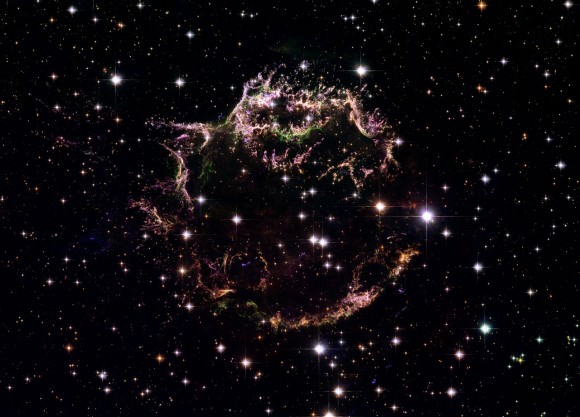
Cassiopeia A, or Cas A, is undoubtedly a supernova remnant. And it also results from a rather recent supernova; but which? There’s some uncertainty, but it seems it was seen, by the astronomer Flamsteed, in 1680. The ACS image above is the most detailed optical images of Cas A; Hubble’s View of Supernova Remnant Cassiopeia A.
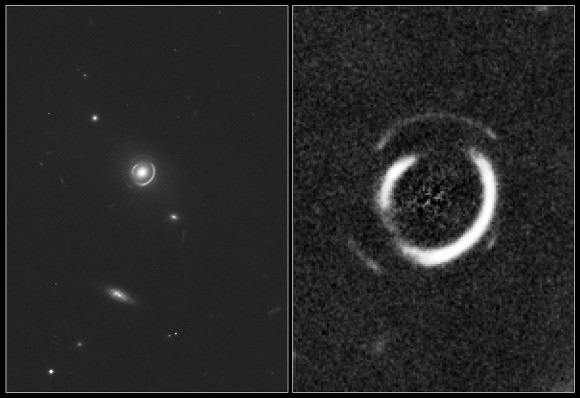
With a galaxy (or cluster) positioned just so in front of a more distant galaxy (or quasar), gravitational lensing will produce an Einstein ring (or a partial ring). Several such rings had been observed prior to 2008, but the one ACS snapped – of SDSSJ0946+1006 – turned out to be a double; three galaxies lined up one behind the other (the right hand image is a highly processed version of the left hand one, with the light of the massive, foreground elliptical galaxy removed). Hubble Sees a Double Einstein Ring.
Tomorrow: 2008 and 2009
Previous articles:
Hubble Turns Sixteen, and Just Keeps on Working
Hubble Enters its Teen Years, More Powerful, More Ambitious
Hubble’s 20th: At Least as Good as Any Human Photographer
Hubble’s 10th Birthday Gift: Measurement of the Hubble Constant
Hubble at 8: So Many Discoveries, So Quickly
Hubble’s 20 Years: Now We Are Six
Hubble’s 20 Years: Time for 20/20 Vision
Hubble: It Was Twenty Years Ago Today
Sources: HubbleSite, European Homepage for the NASA/ESA Hubble Space Telescope, The SAO/NASA Astrophysics Data System
Hubble Turns Sixteen, and Just Keeps on Working
[/caption]
Note: To celebrate the 20th anniversary of the Hubble Space Telescope, for ten days, Universe Today will feature highlights from two year slices of the life of the Hubble, focusing on its achievements as an astronomical observatory. Today’s article looks at the period April 2004 to April 2006.
First, in 1995, there was the Hubble Deep Field (HDF). Then, in 1998, the Hubble Deep Field South (HDF-S). With the new Advanced Camera for Surveys (ACS) aboard, and the Near Infrared Camera and Multi-object Spectrometer (NICMOS) continuing to work well, the Hubble took a new, even deeper, image. And what was it called? Why, the Hubble Ultra-Deep Field (HUDF) of course! The total exposure was approximately a million seconds, and the observations were made in late 2003 and early 2004 (Earliest Star Forming Galaxies Found is Universe Today’s first story on it). Hundreds of scientific papers have been published using data from these observations (and others; a lot of time on major ground-based telescopes has also been devoted to these fields).
In its more than a decade of operation, the Hubble’s main astronomical instruments worked well. Sure, they needed various repairs and were upgraded in one way or another during the four servicing missions to date (remember that 3 was split into two, 3A and 3B), but none failed completely. Well, in August 2004 STIS (the Space Telescope Imaging Spectrograph) did.This intensified the gloom created earlier in the year when NASA Director announced that there would be no more Space Shuttle missions to the Hubble, and his announcements about possible robotic missions left space and astronomy fans cold.
In April 2006, Hubble turned 16; would you have chosen M82 as a ‘sweet sixteen’ snap to put in your album? Universe Today did!
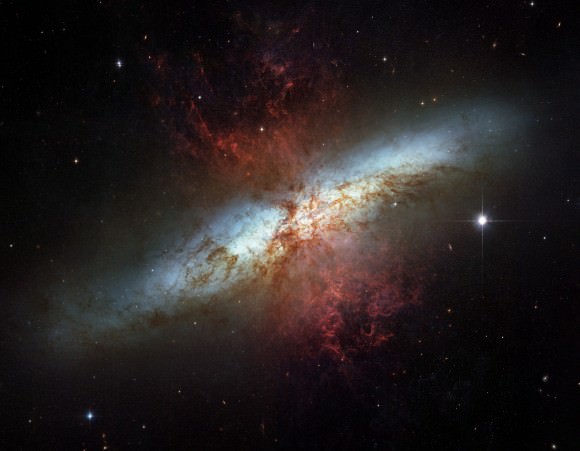
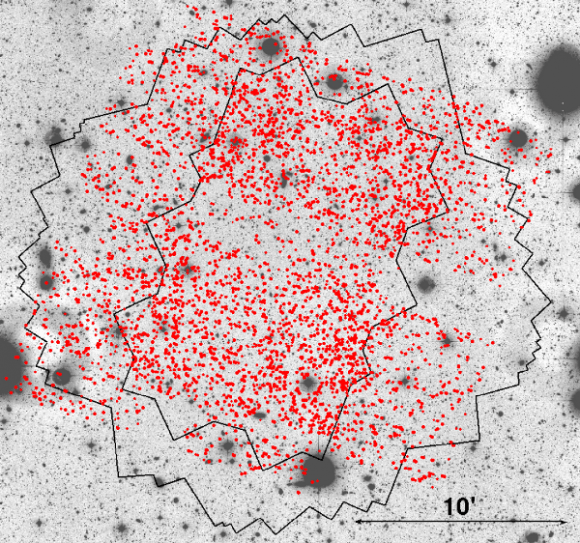
One of the biggest challenges in astronomy today is working out how galaxies formed and evolved. In turn this involves understanding the role of star formation (and its rates), how supermassive black holes accrete matter and create jets, and how dark matter structures form. One powerful way to get at least some answers to the many questions is to point the world’s most powerful telescopes at the same, small, patch of sky for a very long time. Choosing the patch of sky to stare at isn’t easy; for example, ideally you want a ‘hole’ in the Milky Way’s hydrogen, to let you see as clearly as possible in the soft x-ray part of the electromagnetic spectrum. The GOODS team, comprising dozens of astronomers from many institutions, chose two fields, one in the north (centered on the Hubble Deep Field) and one in the south (centered on the Chandra Deep Field-South). The image above gives an idea of what one project involved; the red dots are objects whose spectra were taken (by a spectrograph called VIMOS, on one of the European Southern Observatory’s Very Large Telescopes), overlaid on an image from a ground-based telescope; the contours are the Chandra 2Ms (yes, that’s 2 million seconds) region, and the Hubble ACS GOODS-S field. Over 400 GOODS papers have been published so far, with all sorts of interesting results established. For more information, visit the STScI GOODS website and the ESO one; to get you started, “The Great Observatories Origins Deep Survey: Initial Results from Optical and Near-Infrared Imaging“.
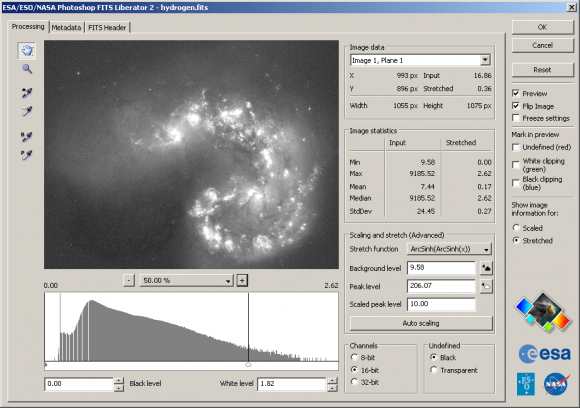
I mentioned earlier – Hubble’s 20th: At Least as Good as Any Human Photographer – that astronomers have their own file format, called FITS, for astronomical data, whether images, spectra, or whatever. Well, FITS is not exactly user friendly (unless you’re an astronomer), so to make the data more accessible, a joint team from the European Space Agency, the European Southern Observatory, and NASA produced the ESA/ESO/NASA Photoshop FITS Liberator, a free plug-in. Why not give it a try?
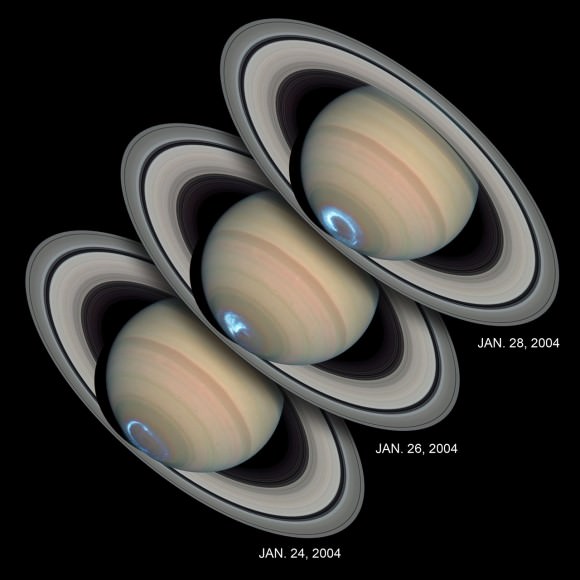
Even though various space probes visit various planets (and their moons), and undertake intensive research of them, good science is still done from afar. Hubble’s studies of Saturn’s aurorae are a good example (Universe Today’s coverage here).
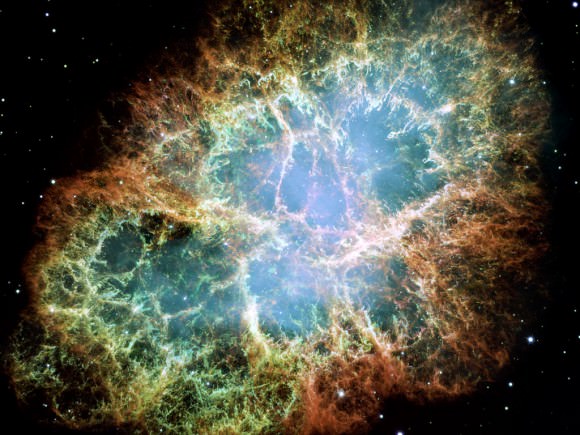
Hubble had taken many images of the Crab Nebula before (see Hubble at 8: So Many Discoveries, So Quickly for example), but the above was a first, in many ways. It was taken by WFPC2, and is actually 24 separate images; it is the highest resolution image of the Crab, to date (Giant Hubble Mosaic of the Crab Nebula is the Universe Today title).
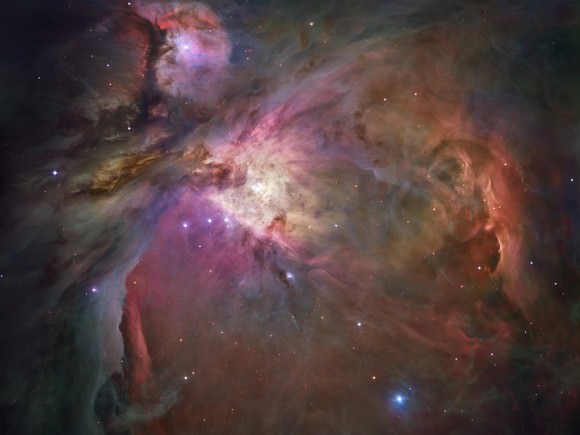
The Orion nebula is the closest ‘star factory’, so receives intense scrutiny by astronomers. Hubble pointed all its imaging instruments at it, in 2005, for over 100 orbits. This image is an ACS mosaic (do you know what the other imaging instruments were, then? Best Orion Nebula Image Ever Taken has the answer).
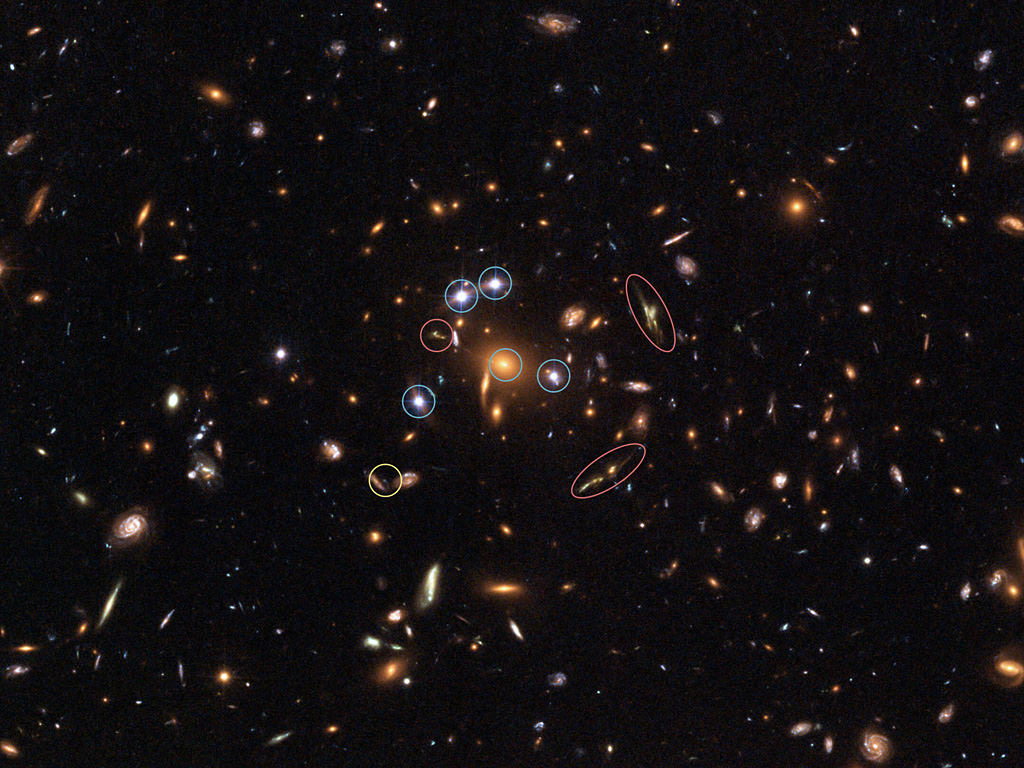
The theory of general relativity predicts gravitational lensing, and this prediction was confirmed in 1919 (do you know how?). When a point source, such as a quasar, is lensed by a foreground object such as a galaxy cluster, the resulting image will have quite specific properties; for example, only an odd number of images, but one image is usually very weak and embedded deep within the light of the lensing object itself. Four images produced by SDSS J1004+4112 (the foreground cluster) had been detected before, but Hubble found the fifth (the blue circles are the quasar, the red a lensed galaxy, the yellow a supernova). Hubble’s Best Gravitational Lens is the Universe Today article on this discovery.
Tomorrow: 2006 and 2007.
Previous articles:
Hubble Enters its Teen Years, More Powerful, More Ambitious
Hubble’s 20th: At Least as Good as Any Human Photographer
Hubble’s 10th Birthday Gift: Measurement of the Hubble Constant
Hubble at 8: So Many Discoveries, So Quickly
Hubble’s 20 Years: Now We Are Six
Hubble’s 20 Years: Time for 20/20 Vision
Hubble: It Was Twenty Years Ago Today
Sources: HubbleSite, European Homepage for the NASA/ESA Hubble Space Telescope, The SAO/NASA Astrophysics Data System

